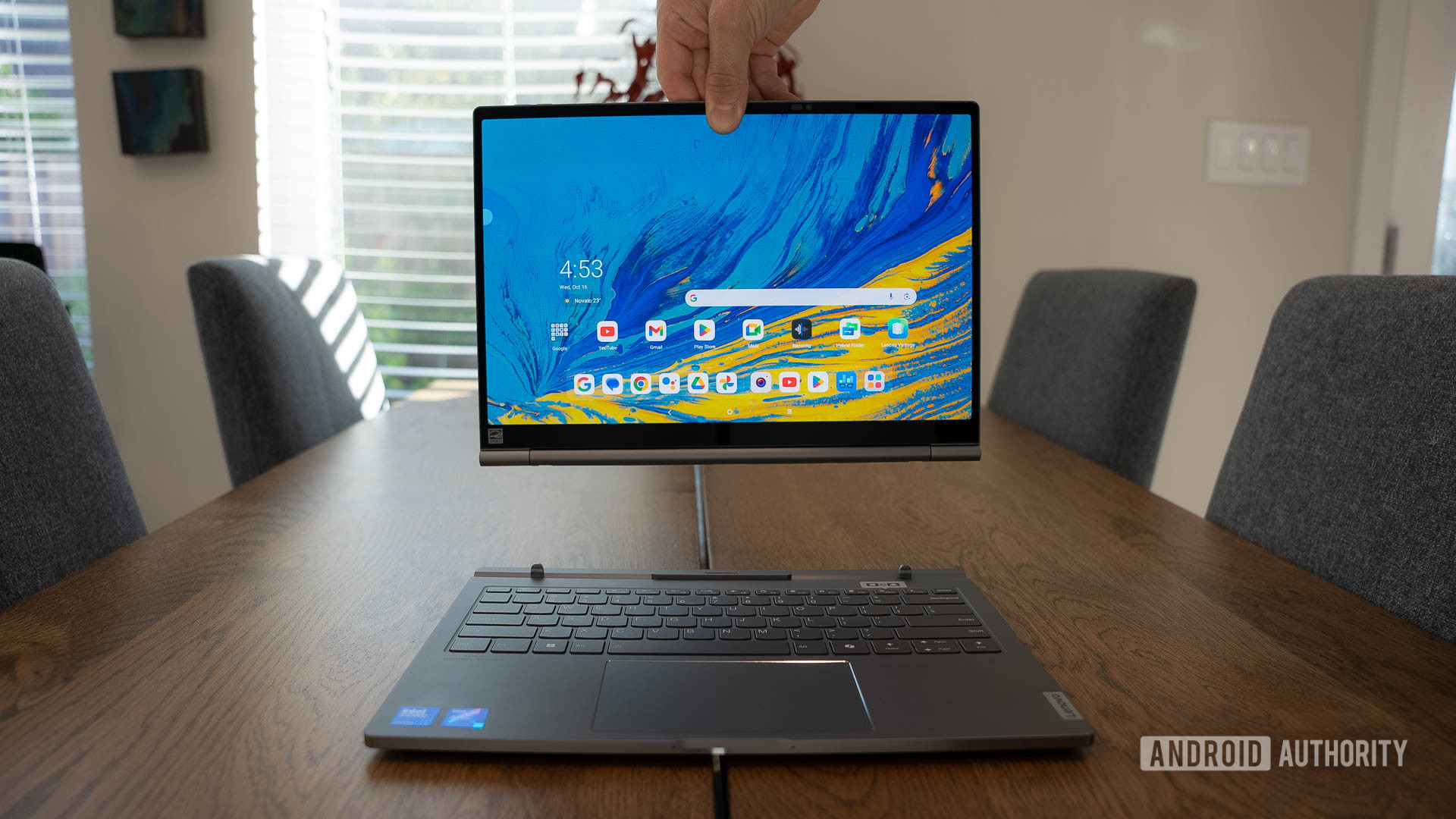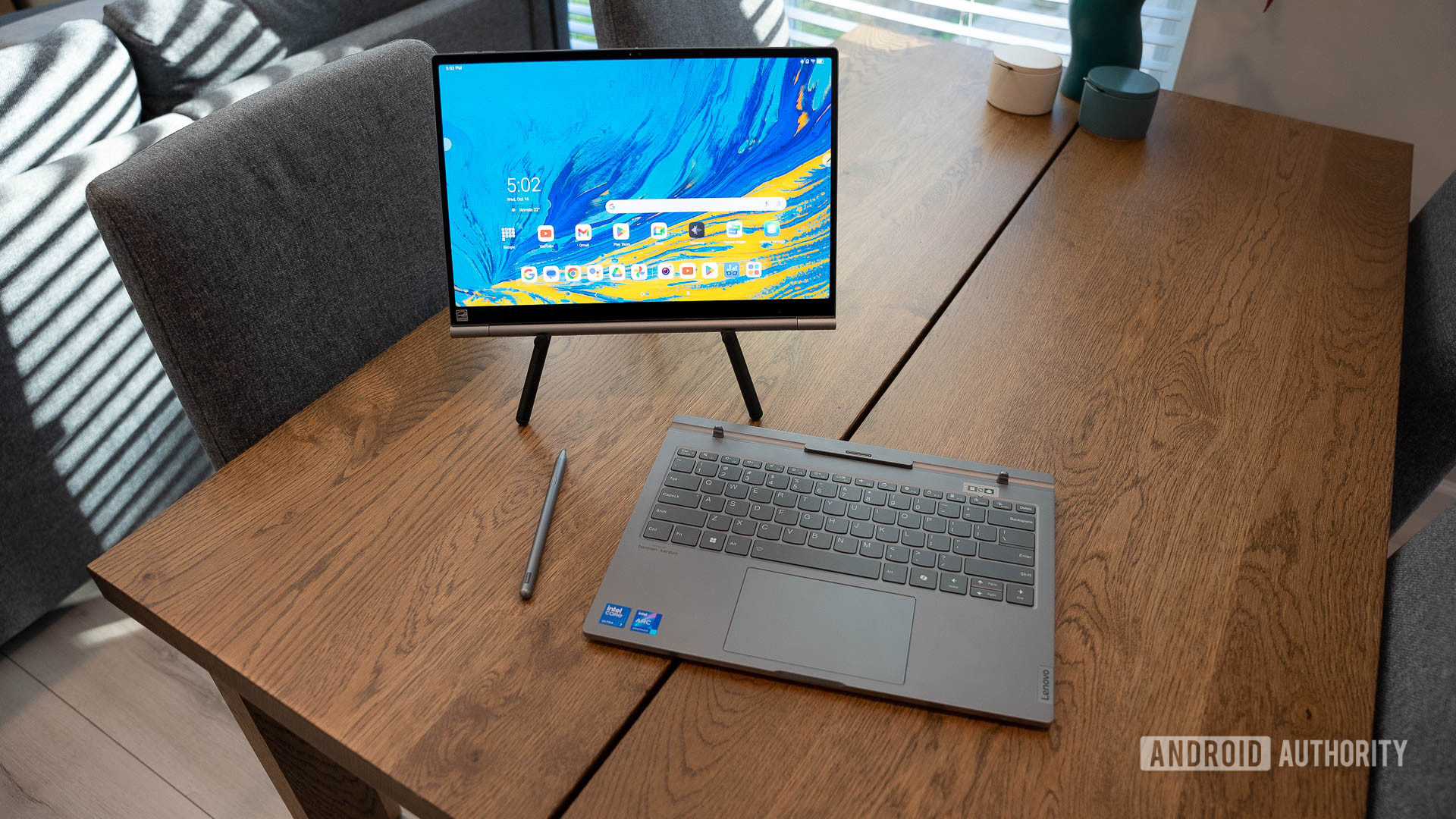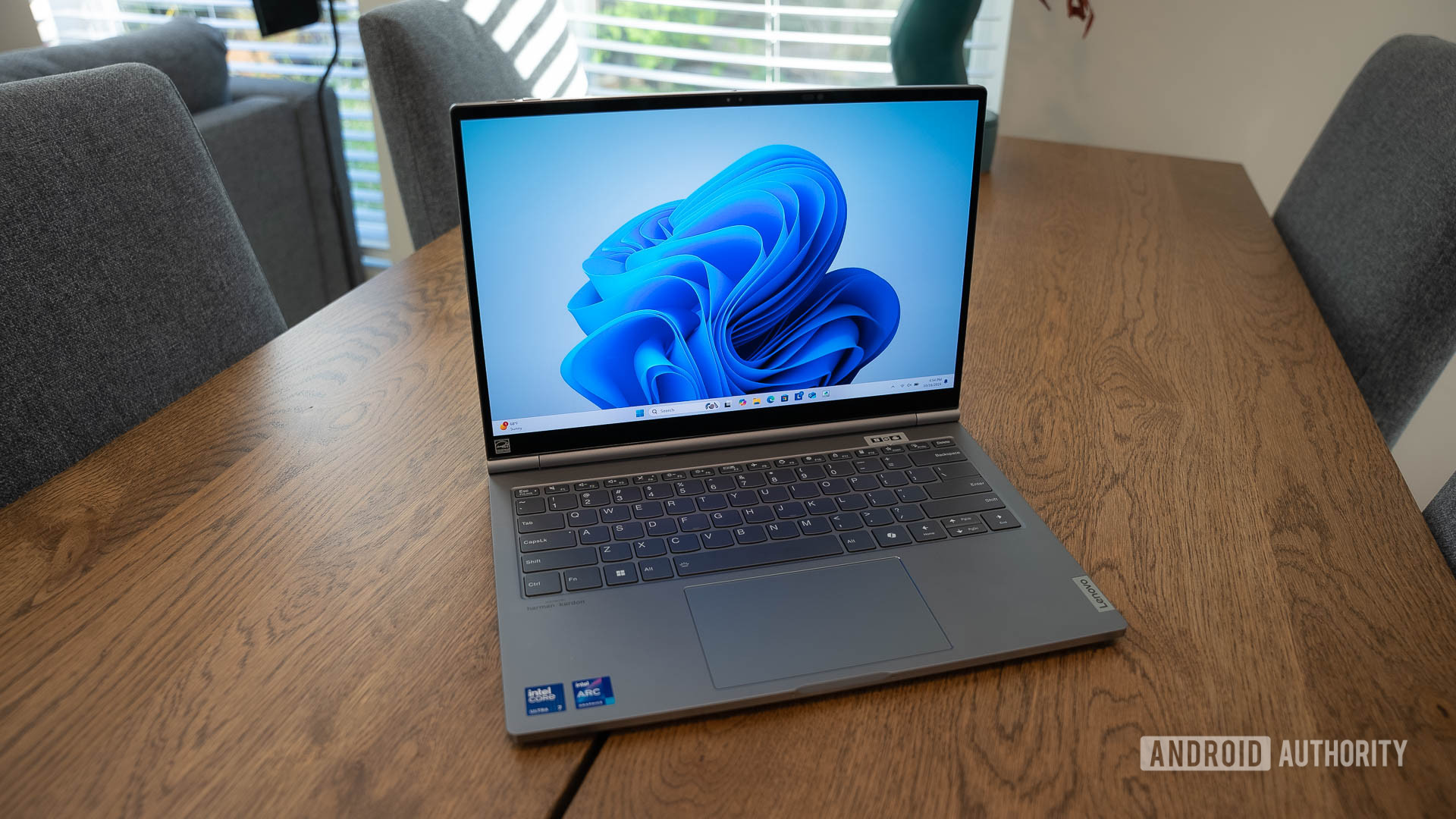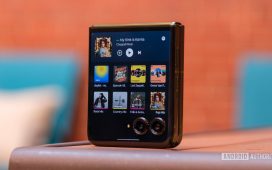Lenovo ThinkBook Plus Gen 5 Hybrid
The Lenovo ThinkBook Plus Gen 5 Hybrid is an amazing idea on paper. Who wouldn’t want access to a powerful Android tablet and an even more powerful Windows laptop all in one machine? However, in practice, the ThinkBook suffers a lot of first-gen problems. It is too heavy, too cumbersome to use, and missing too many obvious software features. It is also astoundingly expensive, which no doubt will ruin its chances of market success. Still, Lenovo deserves a lot of credit for trying something new. Let’s just hope the idea survives for a better, less expensive sequel.
At CES 2024, Lenovo surprised us tech journalists with a brand new machine we weren’t expecting: a Windows laptop that’s also an Android tablet. The Lenovo ThinkBook Plus Gen 5 Hybrid (yes, it’s a ridiculous name) was impressive at first glance, not just to us but also to you: our hands-on video with the ThinkBook Plus Gen 5 Hybrid we filmed in Las Vegas is filled with excited comments from viewers talking about how much they would love to get one.
There were also comments from folks who remembered that devices like this were available many years ago. Some dual-booted Windows and Android, like the ViewSonic ViewPad 10, while others had dedicated hardware for both operating systems. Lenovo itself made one in the early 2010s: the Lenovo IdeaPad U1 Hybrid. It’s interesting that the company should try now, in 2024, to bring that idea back. The question then becomes, was that a good idea?
Well, it took a while, but Lenovo quietly made the ThinkBook Plus Gen 5 Hybrid available for sale at the end of August. The company kindly sent me one to review, and I set out to find out just how useful an Android/Windows hybrid machine really is. The TL;DR is that the idea is sound, but the execution is where Lenovo needs to focus its efforts on the next try.
How the Lenovo ThinkBook Plus Gen 5 Hybrid works

C. Scott Brown / Android Authority
Remember the Microsoft Surface Book? It was a short-lived hybrid laptop with a removable display (Microsoft has since moved on to a more straightforward design, as seen in the 7th-gen Surface Laptop). It allowed users to have the comfort of a clamshell Windows laptop when they needed it and a Windows tablet when they needed something more mobile. The ThinkBook Plus Gen 5 Hybrid is basically the same thing, except when you detach the screen, you don’t continue using Windows 11: you jump into Android 14.
Lenovo calls the two halves of the laptop the Hybrid Station (the keyboard, where Windows lives) and the Hybrid Tab (the screen, where Android lives). Each part is its own separate thing: aside from the display, cameras, keyboard, and trackpad, nothing is shared between them. That means the Android tablet has its own processor (a Snapdragon 8 Plus Gen 1), RAM, battery, Wi-Fi module, etc., while the Windows machine also has its own processor (an Intel Core Ultra 7 155H), RAM, battery, etc.

C. Scott Brown / Android Authority
But, when you connect the two, you have a system that works together to give you the best of both worlds. When attached, with the touch of a button (right next to the F12 key), you can swap back and forth between the two operating systems. You can even window Android, plug in an external monitor, and then have both Android and Windows working simultaneously on two screens. Since each system runs natively on dedicated hardware, there are no performance hits for doing this: you could play Genshin Impact at full tilt on one screen and render a video in Adobe Premiere Pro on the other screen and face no issues (besides heat!).
Because each machine has its own native hardware, the ThinkBook Plus Gen 5 Hybrid can run full versions of Windows 11 and Android 14 at the same time.
Obviously, cramming all this stuff together into one 14-inch laptop is no small feat, so some sacrifices needed to be made. For example, there are only four ports on the entire system: two USB-C Thunderbolt 4 ports (one on either side of the Hybrid Station), a combo mic/audio jack on the left side of the Station, and then a single USB-C port on the Hybrid Tab that lives on the hinge near where the two halves connect (this is also where the tablet’s power button lives).
Speaking of the hinge, removing the Hybrid Tab doesn’t require any button presses or twisting. You literally just yank it off the Hybrid Station. This takes some getting used to, as you really need to pull it off. It took me a while to get it down because I felt like I was going to break it. The thing is a tank, though, so there’s nothing to worry about there.
In addition to the combined system and a 100W wall charger, you also get a powered stylus and a silly little metal easel in the retail box. The stylus is fine — it’s a stylus that does stylus things on either operating system. The easel is a weird choice, but I guess it is nice to have if you want to prop the Hybrid Tab somewhere. I’m just not sure it needed to be made of metal and come with the machine.
Android on top, Windows on the bottom: I love this

C. Scott Brown / Android Authority
I’ll be honest: the geek in me absolutely loves this thing. The idea of being able to use whichever operating system is best for the task without needing to carry around two different devices is simply genius. Really, there’s so much here that Lenovo nailed out of the park.
First, the specs here are top-notch. The Snapdragon 8 Plus Gen 1 in the Hybrid Tab is a few years old but still a beast. Not many tablets have landed with this processor, but our benchmarks show it being very close to a Samsung Galaxy S23 Ultra in terms of sustained CPU and GPU performance, which is interesting because the S23 Ultra has the technically superior Snapdragon 8 Gen 2. This result is primarily due to the size and construction of the tablet — the Hybrid Tab is simply better at keeping cool, so it can be pretty close to the real-world output of the Snapdragon 8 Gen 2.
Likewise, the Intel Core Ultra 7 155H in the Hybrid Station is no slouch, either. It can handle all your productivity needs with ease and can even do high-level tasks like video and image editing. The Intel Arc iGPU will even allow you to play most AAA games, assuming you’re OK with turning the quality settings way down.
The real highlight of the ThinkBook Plus Gen 5 Hybrid, though, is its 2.8K OLED touchscreen display. It’s simply gorgeous, regardless of whether you’re using Android or Windows (or both). It’s not perfect — it only has a 60Hz refresh rate, which is a bit disappointing, and the bezels are very thick — but I found it an absolute joy to use.

C. Scott Brown / Android Authority
I have already told you about how easy it is to swap between Windows and Android with the touch of a button, but Lenovo has also incorporated some interesting software tools that further connect the two systems. All these tools live in the Hybrid Center program, which comes pre-installed on the Windows side. One feature here is Hybrid Folder, which allows you to share files between Android and Windows by simply dragging and dropping them. Anything you add to this special folder is shared across both the tablet and the keyboard, which is great. Another tool allows you to download any photos you take with the tablet automatically. When you connect the two halves, your photos are instantly synced to the Windows Pictures folder.
Lenovo has some clever software tricks to make the two operating systems work together for your benefit.
This being a Lenovo laptop, it also has the brand’s iconic camera shutter that physically disconnects the front-facing 1080p webcam, preventing people from needing to put a piece of tape there. This works on both Android and Windows!
Finally, battery life is pretty great. There’s a 10,000mAh battery in the Hybrid Tab — a little smaller than what we would normally see in a tablet of this size, but still good. Meanwhile, the Hybrid Station has a 75Wh battery, which is pretty standard for a 14-inch laptop. These two batteries combined allow you to extend your system’s battery life by quite a lot when compared to a normal laptop or tablet. For example, you could use the Android tablet until it runs down to nearly zero, connect it to the station, and keep on working with another full tank of gas.
Unfortunately, while I clearly have a lot of great things to say about the ThinkBook Plus Gen 5 Hybrid, there are just as many things about it that didn’t work out so well for me.
First-gen issues galore sour the experience

C. Scott Brown / Android Authority
Although Lenovo had tried to do something like this before with the previously mentioned IdeaPad U1 Hybrid, the ThinkBook Plus Gen 5 Hybrid is very clearly a first-gen product. As I said, it took a lot of engineering prowess to make two things become one, and that means all the refined experiences you expect with a normal laptop aren’t necessarily going to carry over.
Nowhere is this more obvious than in the weight of the device. When the two halves are attached, the full system weighs nearly four pounds. That’s not outrageous or anything, but 14-inch laptops with similar specs — say, the ASUS Zenbook 14 OLED (UX3405) — weigh more than a pound less. Granted, there needs to be a battery in the display (something a normal laptop would not need), and the hinge mechanism definitely adds some heft. Still, Lenovo has plenty of room to trim off some ounces if it makes a second-gen version of this.
The ThinkBook Plus Gen 5 Hybrid is heavy, charging isn’t as convenient as it could be, and knowing when you’re going to be in Windows or Android isn’t always obvious.
Speaking of the batteries, while battery life is great, charging up the batteries isn’t as straightforward as it could be. In my previous example, I said you could run down the Hybrid Tab to nearly zero and then attach it to the Hybrid Station and keep on working. While this is true, once you do run out of juice, there’s no way to choose how you charge each half when they’re attached. In other words, the charger is going to fill up each system at an equal ratio, which you might not want. For example, you might want to charge the Tab first and then charge the Station when that’s full — but you can’t. This could be solved with software, maybe, but it doesn’t currently exist. The only way to solve this issue is to keep the two halves separated and charge them individually, which would require two cables and, if you want to keep working, the use of an external display for the Windows side.
There are other software issues like this. For example, whenever you reattach the display to the Station, you always jump back to Windows. You might be OK with this, but it’s strange Lenovo doesn’t allow you to control the default behavior there. Similarly, when you detach the display, Windows automatically locks. This would be very inconvenient if you had the full kit attached to an external monitor and used it for a Zoom call. If you detach the screen in this scenario, your computer locks, messing up your call.
It’s disappointing Lenovo didn’t figure out ways to bring more continuity between what you’re doing on Windows and what you’re doing on Android.
There’s also no continuity between the two operating systems. If I visit a coffee shop, I need to connect both systems to Wi-Fi, which is annoying. There’s also no task continuation. In other words, if I’m drafting an email in Outlook on Windows, I can’t then continue that email when I switch over to Outlook on Android, even though they are fundamentally the same app. This isn’t technically Lenovo’s problem, but it would have been great to see more investment in software continuity.
Outside of software, the hardware needs some refining, too. I already told you how difficult it is to take the display off, but on top of this, due to the weight of the Hybrid Tab, opening the laptop with one hand is basically impossible, and even opening it with two is tricky. Also, Lenovo made the bizarre decision to include a dual-camera system on the back of the Hybrid Tab. Really, who needs a dual-camera system on the back of a laptop? Yeah, I suppose there might be limited situations where you would want a rear camera for when you’re using it as a tablet, but the system isn’t designed to be taken out on a trip to snap photos. In the end, all this does is add to the device’s overall weight and increase its cost.
And that brings me to the final piece of the puzzle: wowzers, is this thing expensive.
Lenovo ThinkBook Plus Gen 5 Hybrid review: The verdict

C. Scott Brown / Android Authority
I hope you’re ready for this: the Lenovo ThinkBook Plus Gen 5 Hybrid has a list price of over $3,500. That’s a lot of money. Like, a lot of money. To put that into context, you could easily get a 14-inch Windows laptop with similar specs for around $1,500 and then get a high-end Android tablet for $1,000 or less. That means you’re paying a $1,000 premium for the convenience of having those two devices merge into one.
This becomes even more difficult to stomach when you understand that many of the cool things the system can do can be replicated with two separate devices. For example, Quick Share (which is built into Android and can be installed on Windows) makes it dead simple to wirelessly share files between your Android tablet and your Windows laptop. Duet software can allow you to use your laptop’s keyboard and trackpad to control an Android tablet, too. If you buy a tablet that’s made by the same manufacturer as your laptop — say, a Samsung Galaxy Tab S10 Plus ($999.99 at Samsung) and a Galaxy Book 4 ($899.99 at Samsung) — you can even use the tablet as a wireless second screen for your laptop. Yes, you’d need to carry around two devices, but you would save well over $1,000.

Lenovo ThinkBook Plus Gen 5 Hybrid
Unique and innovative • Well-designed • Powerful • Great 2.8K OLED display
Android on top, Windows on the bottom. It’s the best of both worlds!
The Lenovo ThinkBook Plus Gen 5 Hybrid is an Android tablet and a Windows laptop in one machine. Both systems are quite powerful, too. Why carry around a tablet and a laptop when you can combine the two?
To its credit, Lenovo has already put the device on sale a few times — it might even be on sale right now while you’re reading this. But asking $3,500 for a first-gen product you can easily replicate with much less expensive gear is a non-starter.
I want an Android/Windows hybrid laptop. I just don’t really want this one, and certainly not for $3,500.
That all being said, I still love this machine. The idea of it is terrific — Lenovo just needs to refine it. It needs to be lighter, cheaper, and the rough design edges — like how tricky it is to get the display off — need to be sanded down. Additionally, better software integration between the two operating systems is needed.
I applaud Lenovo for stepping out on a limb and trying something different. I really hope there’s a second generation of the ThinkBook Plus Gen 5 Hybrid. However, I’m concerned that this model won’t sell well because of its price, and Lenovo will erroneously conclude that people don’t want an Android/Windows hybrid. Here I am, Lenovo: I want this idea to work. I just don’t think this particular product is worth it. Please give us another try!









